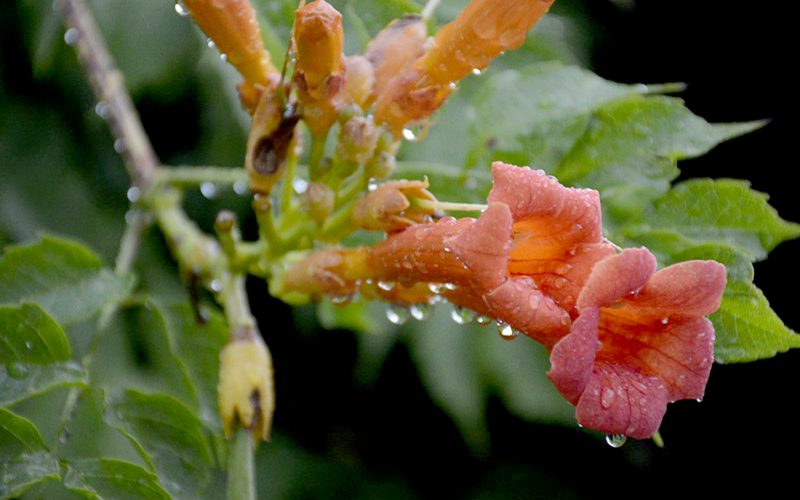
Staff Photo Amanda Bancroft
This trumpet vine blooms beautifully outside Little Bread Co. on Block Street in Fayetteville.
Like a three-dimensional character, some plants play the flawed hero role. It’s a native here, but invasive in other areas. It feeds hummingbirds, but can make your dog sick if ingested. The blooms look gorgeous while it strangles any tree it’s growing on. Children love playing with the trumpets on their fingers, and it gives some of them a rash. Botanists promoting native habitat rescue it from being mowed down along roadsides, while others consider it an aggressive weed and promptly dig it all up.
Trumpet vines (Campsis radicans) are native to the southeast and bloom throughout summer, but it’s also an aggressive spreader. The USDA calls it an invasive weed. Butterfly and hummingbird conservation groups call it an important native nectar source. Truthfully, it’s both! Without high-maintenance control through regular pruning, it can be problematic to surrounding vegetation and it’s been spreading far outside the native range. It has been called malicious, evil, monstrous, and even a “form of domestic terrorism” that gardeners have fought with for years. The main issue seems to be that, although it feeds wildlife and is a part of our native ecosystem, it’s difficult to remove or kill, and can damage trees and structures like houses or swimming pools while giving the gardener an itchy rash.
It’s sometimes called “cow-itch” because contact with the leaves, flowers or bark causes mild skin irritation in some mammals. Supposedly, this should only last a few hours, but allergic people have complained that it took weeks for the rash to disappear. Others, like this writer, have never had even a mild reaction. In contrast, birds often love nesting in it!
Like wisteria, clematis, or Virginia creeper, which are all toxic, trumpet vines can cause digestive upset if ingested (although apparently more mild than the others) so it’s not safe for children or pets. It’s probably a best practice to simply not allow children and pets to eat random plants growing in the yard or woods, because even having a non-toxic yard doesn’t mean that birds won’t drop a volunteer toxic plant seed or two eventually.
Should we wipe out this villainous hero or plant it? Perhaps both. It depends. If the plant is not native to your area, removing it is clearly an eco-conscious choice. If you’re in its native range, including Northwest Arkansas, and have thoroughly researched the plant, are not highly allergic, and know how to control it through annual pruning, potting, “deadheading” and seed pod elimination, then go ahead and plant it (or keep it, if you inherited it) for the wildlife and beauty it can bring. If not, surely don’t. It can cause property damage, dermatitis, and the elimination of favorite trees or other native plants, so be careful. Keep in mind there are other options which serve the same ecological and aesthetic purpose: knowledge is power!
Amanda Bancroft is a writer, artist, and naturalist building an off-grid cottage for land conservation on Mt. Kessler. She and her husband Ryan blog about their adventures and offer a solar-hosted online educational center on how to make a difference with everyday choices at: www.RipplesBlog.org.










